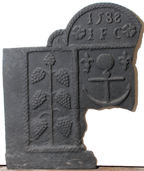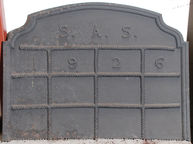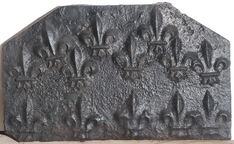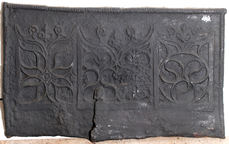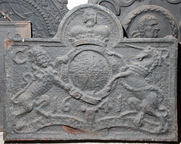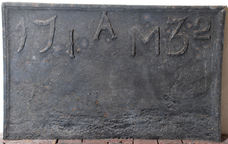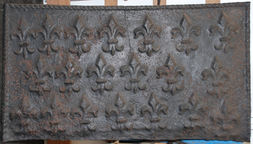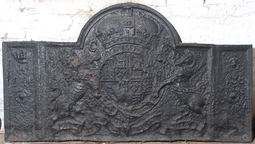-
439
Description: Fragment; left part only; this fireback comprises at least four separate elements: the rectangular central panel has an anchor with coiled rope between two fleurs de lys, below which are two roses; the rectangular side panels each comprise a vertical stem with six ‘grape bunches’ surmounted by a circular grape cluster; above, a semicircular arch contains the initials between two roses as in the central panel, with the date above; where the arch meets the central panel there is an arc across each corner. The side and top panels are edged with simulated twisted rope; to the left and botoom, a plain extension has been added before casting.
Notes: One of an unusual series formed from separate panels. The left panel is likely to have been repeated in the missing section. The extensions to the side and bottom will be unique to this casting which, because of the sharpness of the relief detail, is probably an early example. Because of its date and the use of the anchor motif, this much-copied plate is often referred to as the Armada fireback. No other connection with the sea battle is known. Other firebacks have been cast using some of the separate elements described.
Inscription: 1588 / IFC
- Decoration tags:
- rectangular with round arch (shape)
- none (edging)
- carved pattern panels
- heraldic
- text
- plants
- objects
Manufactured: in 1588 in the Weald area of England.
Current location: Anne of Cleves House, Southover High Street, Lewes, East Sussex, England.
Museum number: 1944.24.060 (part of the Sussex Archaeological Society museum group)
- Attached to series:
- Armada series
-
440
Description: Rectangle joined to low arch with cyma recta curves; ovolo-moulded edging (top and sides); grid of twelve rectangles (4 columns of 3) with twisted rope borders; initials in arch, date in top line of rectangles.
Notes: A fireback cast specially to mark the 60th anniversary of the Sussex Archaeological Society, and donated to the society by Mr John Every.
Inscription: S.A.S. / 1926
- Decoration tags:
- rectangular with canted top corners and round arch (shape)
- ovolo (edging)
- simple stamps
- individual letters
- individual numbers
- text
- objects
Manufactured: in 1926 at Phoenix Foundry, Lewes in the Weald area of England.
Current location: Anne of Cleves House, Southover High Street, Lewes, East Sussex, England.
Museum number: 1944.24.093 (part of the Sussex Archaeological Society museum group)
- Attached to series:
- Miscellaneous stamp firebacks
- Date & initials firebacks
-
441
Description: Sub-rectangular; edged with a repeated length of helically-turned dowel (top and sides); apparently random arrangement of same piece of dowel repeated ten times, including a saltire and cross.
Notes: Apart from the Christian significance of the cross, the other arrangements of rope lengths may be apotropaic in their purpose, the double V being a possible invocation of the Virgin. The blemishes at the base are caused by the casting sand being disturbed by the pouring of the metal.
- Decoration tags:
- rectangular (shape)
- rope (edging)
- simple stamps
- apotropaic
- objects
Manufactured: in the 16th century in the Weald area of England.
Current location: Anne of Cleves House, Southover High Street, Lewes, East Sussex, England.
Museum number: LH000.799 (part of the Sussex Archaeological Society museum group)
Citation: Dawson, C., 1903, 'Sussex Iron Work and Pottery', Sussex Archaeological Collections, 46, pp. 1-54.
Citation: Gardner, J. S., 1898, 'Iron Casting in the Weald', Archaeologia, 56, 1, pp. 133-164.
- Attached to series:
- Rope design firebacks
-
442
Description: Fragment: right part only; rectangular; twisted rope edging; lion passant with rose stamped twice above and below rear end, crowned rose below fore end; bottom right corner, two small walking figures, one with both arms down, the other with right arm raised.
Notes: One of a series with the same and other stamps.
- Decoration tags:
- rectangular (shape)
- rope (edging)
- carved stamps
- heraldic
- royal
- animals
- humans
- plants
Manufactured: in the mid-16th century in the Weald area of England.
Current location: Anne of Cleves House, Southover High Street, Lewes, East Sussex, England.
Museum number: LH001.005 (part of the Sussex Archaeological Society museum group)
- Attached to series:
- Royal series
-
443
Description: Canted rectangle; plain plate with two rows of fleurs de lys, eight in the top row, three off set above the other five, and five in a single row along the bottom.
Notes: The fleurs-de-lys are the same as are seen on firebacks thought to have been cast at Pounsley.
- Decoration tags:
- rectangular with canted top corners (shape)
- none (edging)
- carved stamps
- heraldic
Manufactured: in the mid- to late-16th century possibly at Pounsley Furnace, Framfield in the Weald area of England.
Current location: Anne of Cleves House, Southover High Street, Lewes, East Sussex, England.
(part of the Sussex Archaeological Society museum group)
Citation: Butterfield, W. R., 1916, 'Old Wealden Firebacks', The Connoisseur, 46, pp. 197-209.
- Attached to series:
- Pounsley series
-
444
Description: Rectangular; top and side edging formed from the repeated stamping of a short length of twisted rope; three gothic panels arranged horizontally, the centre one wider than the other two, each panel a symmetrical arrangement of tracery patterns with an inverted ogee arch on top incorporating two flowers; a separate fleur-de-lys stamp has been repeated above each panel.
Notes: The panels were probably derived from a dismantled wooden chest or hutch table, c.1500. Their gothic style belies the probable age of the fireback, such chests already being old when their parts might have been re-used. H.R. Schubert (1957, p.259) speculated that this fireback might have been imported from Cleves, where a furnace near Stolberg produced similar castings. That the same panels are on a fireback at Nymans, Handcross (no. 99), makes English manufacture more probable.
- Decoration tags:
- rectangular (shape)
- rope (edging)
- carved pattern panels
- architectural
- objects
Manufactured: in the early- to mid-16th century in the Weald area of England.
Current location: East Grinstead Museum, East Grinstead, West Sussex, England.
Museum number: LH000.796 (part of the Sussex Archaeological Society museum group)
Citation: Butterfield, W. R., 1916, 'Old Wealden Firebacks', The Connoisseur, 46, pp. 197-209.
Citation: Dawson, C., 1903, 'Sussex Iron Work and Pottery', Sussex Archaeological Collections, 46, pp. 1-54.
- Attached to series:
- Gothic panel series
- Furniture stamp firebacks
-
445
Description: Arched rectangular shape; cavetto moulded edging; garter enclosing Stuart royal arms, with supporters, crown and motto; date split either side of garter buckle.
Notes: The style of the numerals is very similar to those on a plate bearing a lion, dated 1656, and is likely to be the work of the same pattern-maker; a variant (no. 253) has a substituted date of 1664.
Inscription: C R / 16 41
Arms: English Stuart royal
- Decoration tags:
- rectangular with round arch (shape)
- cavetto (edging)
- whole carved pattern
- armorial
- royal
- text
Manufactured: in 1641 in the Weald area of England.
Current location: Anne of Cleves House, Southover High Street, Lewes, East Sussex, England.
(part of the Sussex Archaeological Society museum group)
- Attached to series:
- Carolean royal armorial firebacks
- Stuart royal armorial firebacks
- Royalist series
-
447
Description: Rectangular; ovolo-moulded edging; inscription across top of plate, numerals, except '2', larger than letters, 'A' raised above 'I' and 'M'.
Notes: A late, and rather unsophisticated example of the use of individual stamps.
Inscription: 17 IAM 32
- Decoration tags:
- rectangular (shape)
- ovolo (edging)
- individual letters
- individual numbers
- text
Manufactured: in 1732 in the Weald area of England.
Current location: Anne of Cleves House, Southover High Street, Lewes, East Sussex, England.
Museum number: LH000.950 (part of the Sussex Archaeological Society museum group)
- Attached to series:
- Date & initials firebacks
-
448
Description: Rectangular; twisted rope edging (top and sides); fleur de lys arranged in a pattern of 20, in three rows: 7-6-7.
Notes: A type of fleur-de-lys used on firebacks possibly cast at Pounsley Furnace.
- Decoration tags:
- rectangular (shape)
- rope (edging)
- carved stamps
- heraldic
Manufactured: in the mid- to late-16th century possibly at Pounsley Furnace, Framfield in the Weald area of England.
Current location: Hall Place, Bexley, Kent, England.
Museum number: 1944.24.039 (part of the Sussex Archaeological Society museum group)
- Attached to series:
- Pounsley series
-
449
Description: Arched rectangular shape; cavetto edging; armorial; Stuart English royal arms within a circular garter; crown, motto and supporters (crowned lion and unicorn); initials separated by crown; left rectangular extension panel with double ovolo-moulded edging; top, putto face above initials in triad, with floral patera below; right rectangular extension panel with double ovolo-moulded edging; top, putto face above date, with floral patera below.
Notes: A widely copied armorial fireback with extension panels of a style associated with other date and initial firebacks; the central fireback measures 1080 x 860mm.
Inscription: [central fireback] C [R missing] / ..I SOI T.QVI.MAL.Y. ...SE; [left panel] IRM [triad]; [right panel] 1686
Arms: English Stuart royal
- Decoration tags:
- rectangular with round arch (shape)
- complex individual (edging)
- carved stamps
- whole carved pattern
- individual letters
- individual numbers
- extension panels
- armorial
- royal
- text
Manufactured: in 1686 in the Weald area of England.
Current location: Anne of Cleves House, Southover High Street, Lewes, East Sussex, England.
Museum number: LH000.951 (part of the Sussex Archaeological Society museum group)
